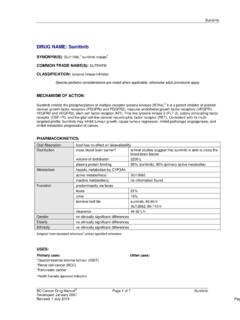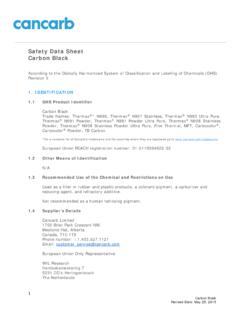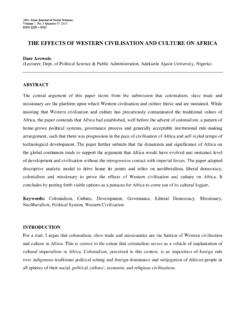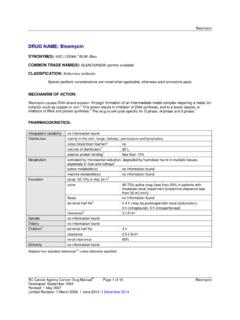Transcription of DRUG NAME: Imatinib - BC Cancer
1 Imatinib DRUG name : Imatinib synonym (S): STI-571, Imatinib mesylate common trade name (S): GLEEVEC , GLIVEC CLASSIFICATION: tyrosine kinase inhibitor Special pediatric considerations are noted when applicable, otherwise adult provisions apply. MECHANISM OF ACTION: Imatinib inhibits BCR-ABL tyrosine kinase, the fusion protein created by the Philadelphia chromosome abnormality that characterizes chronic myeloid leukemia. Competitive inhibition at the enzyme's ATP-binding site leads to inhibition of tyrosine phosphorylation of proteins involved in BCR-ABL signal Inhibition is not completely selective as Imatinib also inhibits the receptor tyrosine kinases for platelet-derived growth factor and c-Kit, a stem cell Cells that express BCR-ABL undergo growth inhibition or apoptosis but normal cells are not ,2 PHARMACOKINETICS: Interpatient variability 40% for clearance Oral Absorption 98% mean absolute bioavailability; not affected by fatty food3 time to peak plasma concentration 2-4 h Distribution extensively bound to plasma protein cross blood brain barrier?
2 Animal studies showed poor penetration4 volume of distribution ~ 295 L5 plasma protein binding 95%, mostly to albumin and 1-acid glycoprotein Metabolism 75%, primarily oxidative6 via CYP3A4/5; main active metabolite is equipotent to Imatinib . Other CYP450 enzymes (1A2, 2D6, 2C9, 2C19) have a minor role. active metabolite(s) N-desmethyl derivative (CGP 74588)6 inactive metabolite(s) none known Excretion fecal and urinary excretion urine 13% over 7 days feces 68% over 7 days terminal half life Imatinib : 18 h CGP 74588: 40 h clearance 13-17 L/h5 Gender no clinically significant difference7 Elderly small effect of age on the volume of distribution (12% increase in patients > 65 years old); not clinically significant7 Children no clinically significant difference Adapted from reference2 unless specified otherwise. USES: Primary uses: Other uses: *leukemia, chronic myeloid (CML)2,8 leukemia, acute (Ph+)9-129,11 *sarcoma, gastrointestinal stromal tumour (GIST)13 *Health Canada Therapeutic Products Programme approved indication BCCA Cancer Drug Manual Page 1 of 8 Imatinib Developed: 1 May 2004 Limited Revision: 1 March 2017 Imatinib SPECIAL PRECAUTIONS: Contraindications: history of hypersensitivity reaction to imatinib2 pregnancy14,15 Caution: Longterm treatment may result in a progressive loss of renal function over time; monitor renal function prior to treatment and periodically ,16 Reactivation of Hepatitis B virus (HBV) has sometimes occurred in chronic carriers of HBV after receiving BCR-ABL tyrosine kinase inhibitors.
3 Test for HBV infection prior to treatment and monitor for signs of active HBV Carcinogenicity: Carcinoma was seen at doses of 30-60 mg/kg/day in an animal carcinogenicity study. No significant increase in second malignancies was seen in clinical Mutagenicity: Imatinib was not mutagenic in the Ames test and mammalian in vitro mutation test. Two intermediates of the manufacturing process, which are present in the final product, are mutagenic in the Ames test. Imatinib is clastogenic in mammalian in vitro Fertility: Effects on male fertility have not been studied in patients. There is clinical evidence of both profound oligospermia and maintained male fertility as well as pre-clinical evidence of impaired spermatogenesis also without reduced No information was found with regards to female fertility. Pregnancy: Spontaneous abortions and congenital anomalies have been reported by women taking Imatinib during pregnancy.
4 In animal studies, dose dependent embryo-fetal toxicity and/or teratogenicity (exencephaly, encephalocele, and absent or reduced frontal, parietal, and/or intraparietal bones) have been observed in rats, but not in rabbits. For women of childbearing potential, a serum or urine pregnancy test is recommended to confirm that female patients are not pregnant prior to treatment with Imatinib . Effective contraception should be used during Breastfeeding is not recommended because an amount equivalent to 30% of the maternal dose per unit body weight has been found in breast milk in animal SIDE EFFECTS: The table includes adverse events that presented during drug treatment but may not necessarily have a causal relationship with the drug. Because clinical trials are conducted under very specific conditions, the adverse event rates observed may not reflect the rates observed in clinical practice.
5 Adverse events are generally included if they were reported in more than 1% of patients in the product monograph or pivotal trials, and/or determined to be clinically important. ORGAN SITE SIDE EFFECT Clinically important side effects are in bold, italics blood/bone marrow febrile neutropenia anemia; newly diagnosed CML and GIST (severe 3-4%);CML accelerated phase and blast crisis (severe 40-50%) anemia, hemolytic (rare)19,20; generally occurs within 1-4 weeks20 bone marrow necrosis (<1%); generally occurs within 1-4 weeks21 myelodysplasia (<1%); generally occurs after more than 3 months22,23 neutropenia; newly diagnosed CML and GIST (severe 8-13%);CML accelerated phase and blast crisis (severe 58-63%); median duration 2-3 weeks splenic rupture (<1%); generally occurs after more than 1-3 months24 BCCA Cancer Drug Manual Page 2 of 8 Imatinib Developed: 1 May 2004 Limited Revision: 1 March 2017 Imatinib ORGAN SITE SIDE EFFECT Clinically important side effects are in bold, italics thrombocytopenia (severe 17-58%).
6 Newly diagnosed CML and GIST (severe 1-7 %) CML accelerated phase and blast crisis (severe 40-50%); median duration 3-4 weeks cardiovascular (general) cardiac tamponade (<1%); generally occurs after more than 3 months25 congestive heart failure (<1%); generally occurs after 7 months26 edema (52-68%, severe 2-10%); more common in > 65 years old constitutional symptoms fatigue (24-33%, severe 0-3%) fever (14-38%, severe 1-7%) night sweats (8-10%, severe 0-1%) weakness (5-10%, severe 0-3%) weight gain (1-4%, severe 0-2%) dermatology/skin cutaneous reactions, severe (<1%)20,27-45 photosensitivity (<1%)28 pruritus (6-10%, severe 0-1%) rash (32-39%, severe 3-4%) gastrointestinal emetogenic potential: low moderate anorexia (3-14%, severe 0-2%) constipation (4-13%, severe <1%) diarrhea (33-39%, severe 3-4%) diverticulitis ( 1%)18 gastrointestinal perforation (< 1%)18 nausea (55-68%, severe 2-5%) vomiting (28-49%, severe 1-3%) endocrine gynecomastia ( 1%)28.
7 Generally occurs after more than 3 months46 hemorrhage bleeding episode (13-48%, severe 8-16%) CNS bleeding ( 4%, severe 0-2%) epistaxis (3-12%, severe 0-3%) gastrointestinal bleeding ( 5%, severe 0-3%) petechiae (1-10%, severe 0-1%) hepatic elevated bilirubin (severe 0-4 %) elevated ALT, AST, alkaline phosphatase (severe 1-6 %) hepatic necrosis, early to delayed (<1%); generally occurs after more than 1-3 months47,48 infection pneumonia (1-10%, 0-5%) varicella-zoster virus infection (2%); generally occurs after 1-3 months49 metabolic/laboratory hypokalemia (2-12%, severe 0-3%) musculoskeletal arthralgia (21-26%, severe 1-5%) avascular necrosis/hip necrosis (<1%)18 BCCA Cancer Drug Manual Page 3 of 8 Imatinib Developed: 1 May 2004 Limited Revision: 1 March 2017 Imatinib ORGAN SITE SIDE EFFECT Clinically important side effects are in bold, italics muscle cramps (25-46%, severe <1%) myalgia (7-18%, severe 0-2%) ocular/visual periorbital edema2 (70%, rarely severe)50-52; generally occurs after more than 1-3 months51,52 watery eye (12%)50 pain abdominal pain (20-23%, severe 0-5 %) headache (24-28%, severe 0-4%) pain (27-39%, severe 1-8%) pulmonary cough (9-22%, severe 0-1%) dyspnea (5-12%, severe 0-5%) pneumonitis (<1%)28,53-55; generally occurs within 1-3 months54,55 pleural effusions (<1%)28,56 pulmonary alveolar proteinosis (<1%).
8 Generally occurs after more than 1-3 months57 nasopharyngitis (5-10%, severe 0-1 %) renal/genitourinary elevated creatinine (severe <1%) renal failure, acute (<1%)58,59; may occur after one week58 to two months59 renal dysfunction, progressive14,16; loss of function may be greatest in first year, may contribute to development or worsening of some kidney diseases syndromes tumour lysis syndrome (<1%) ; generally occurs within 4-5 days60,61 Adapted from reference2 unless specified otherwise. Bone marrow suppression, especially neutropenia and thrombocytopenia, is more common at higher doses (>750 mg/day) and in blast crisis or accelerated phase compared to chronic phase when treating chronic myeloid leukemia. Management is dose reduction, interruption or (rarely) discontinuation of Filgrastim at a dose of 300-480 mcg two to three times weekly62,63 or daily64 has also been used.
9 Edema is usually mild to moderate and most frequently periorbital or in lower limbs but may include pleural effusion, ascites, pulmonary edema and rapid weight gain with or without superficial Serious or life threatening edema has rarely been reported, including periorbital edema,51,52 intramuscular edema,65 and cerebral It appears to be dose related (especially > 600 mg /day) and is more common in the elderly and female Edema may be due to inhibition of platelet-derived growth factor receptor which regulates interstitial fluid pressure. Onset varies from weeks to ,52,65,66 Management is largely symptomatic with diuretics, other supportive measures or Imatinib dose Hepatotoxicity with severe elevations of transaminases or bilirubin may be life threatening. Liver function (transaminases, bilirubin, alkaline phosphatase) should be monitored before initiation of treatment and monthly or as clinically indicated.
10 Management of hepatotoxicity is dose reduction, interruption (median duration one week) or discontinuation (< ) of Hepatitis B virus (HBV) reactivation has been reported in chronic HBV carriers and patients with a documented history of hepatitis B after receiving BCR-ABL inhibitors. Increased viral load or positive serology may occur with HBV reactivation. Some cases have included acute hepatic failure or fulminant hepatitis leading to liver transplantation or death. The mechanism and frequency of HBV reactivation is not known but may occur at any time during treatment, and is considered a class effect of the BCR-ABL TKIs. Test for HBV infection prior to treatment and monitor for symptoms of active HBV infection during treatment and for several months after termination of BCCA Cancer Drug Manual Page 4 of 8 Imatinib Developed: 1 May 2004 Limited Revision: 1 March 2017 Imatinib Severe skin reactions are rare and varied in presentations,27,28 including exanthematous (erythematous) reactions,28-32 erythroderma and exfoliative dermatitis,20,28,32,33 eruptions,28,34-37 pigmentation reactions,28,38-41 photosensitisation,28,40 hemorrhagic blisters,42,43 and inflammation of subcutaneous fat tissue44 and blood The onset is variable and may be early,30,32,45 delayed38-41 or The median onset was about 1-2 months30,32,45 but may be more delayed with pigmentation changes38,39,41 and Skin biopsies tended to show infiltration of inflammatory cells27,32,39,45 and reactions seemed to be ,32,39,45,67 Management is largely symptomatic, including discontinuation or reduction of dose,oral and/or topical corticosteroids, antihistamines and ,30,32,39,45,64,67 INTERACTIONS.


















